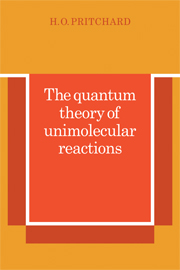Book contents
- Frontmatter
- Contents
- Preface
- Acknowledgements
- 1 The observed properties of thermal unimolecular reactions
- 2 The master equation for internal relaxation in molecules
- 3 Reaction as a perturbation of the internal relaxation
- 4 The specific rate function k(E) as an inverse Laplace transform
- 5 Unimolecular fall-off in strong collision systems
- 6 A molecular dynamic approach to specific rate functions
- 7 Building in the randomisation processes
- 8 Weak collision processes
- 9 How well does it all work?
- Appendix 1 Units, symbols, and errata
- Appendix 2 Rate constants for the thermal isomerisation of cyclopropane and for the thermal decomposition of cyclobutane
- Appendix 3 Computer programs for thermal unimolecular reactions
- Exercises
- References
- Author index
- Subject index
8 - Weak collision processes
Published online by Cambridge University Press: 04 August 2010
- Frontmatter
- Contents
- Preface
- Acknowledgements
- 1 The observed properties of thermal unimolecular reactions
- 2 The master equation for internal relaxation in molecules
- 3 Reaction as a perturbation of the internal relaxation
- 4 The specific rate function k(E) as an inverse Laplace transform
- 5 Unimolecular fall-off in strong collision systems
- 6 A molecular dynamic approach to specific rate functions
- 7 Building in the randomisation processes
- 8 Weak collision processes
- 9 How well does it all work?
- Appendix 1 Units, symbols, and errata
- Appendix 2 Rate constants for the thermal isomerisation of cyclopropane and for the thermal decomposition of cyclobutane
- Appendix 3 Computer programs for thermal unimolecular reactions
- Exercises
- References
- Author index
- Subject index
Summary
In his discourse on the theory of unimolecular reactions, Bunker associated the onset of weak collision effects with the breakdown of either the strong collision or the randomisation assumptions [66.B2]. We have already constructed (in Chapter 7) an apparatus for examining the latter problem, and we will now attempt to inspect the problem of departures from the strong collision transition rates. By introducing the concept of a generalised strong collision, Nordholm and I have rendered the problem of detecting such departures a little more difficult. In the past, an internal relaxation rate lower than the hard sphere collision rate could be taken as, more-or-less, prima facie evidence for the weakness of the collisions, but as we have seen in the two preceding chapters, both cyclopropane (which conforms exactly to strong collision fall-off behaviour) and methyl isocyanide (which departs only very slightly from such behaviour) both appear to have internal relaxation rates of about one-tenth of the hard sphere collision rate. I have identified this so-called strong collision behaviour with an absence of dispersion in the rates of the normal-mode processes which are important in feeding the reactive states of the molecule. By this definition, collisions between helium and methyl isocyanide are probably strong, as we saw in Section 7.3, and so are collisions between argon and cyclopropane, as I will demonstrate in Section 9.4.
- Type
- Chapter
- Information
- The Quantum Theory of Unimolecular Reactions , pp. 101 - 109Publisher: Cambridge University PressPrint publication year: 1984



